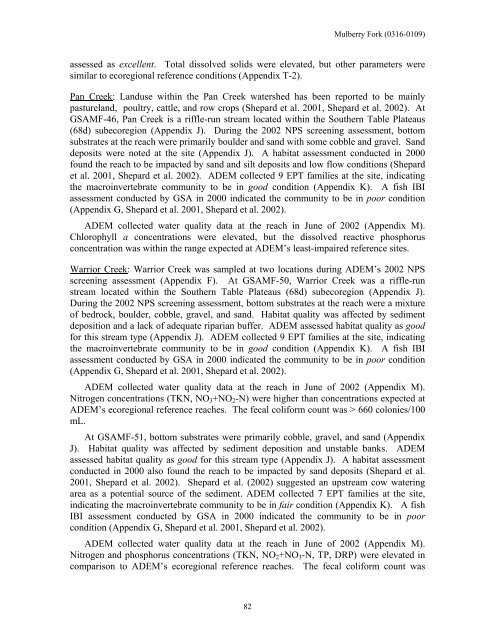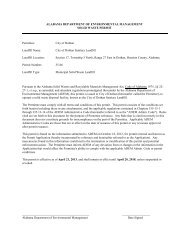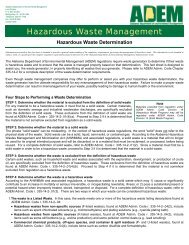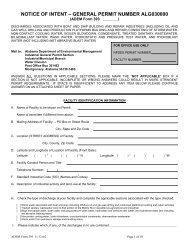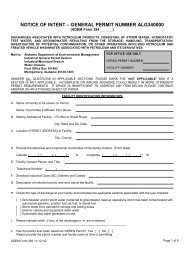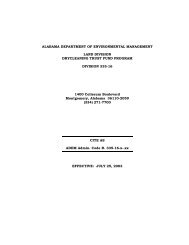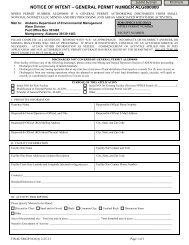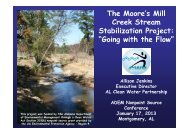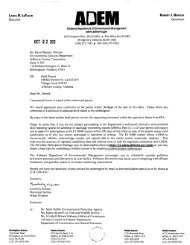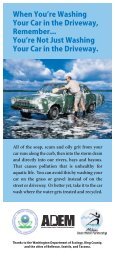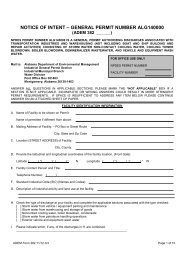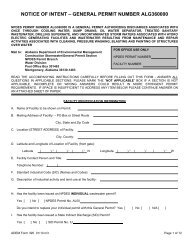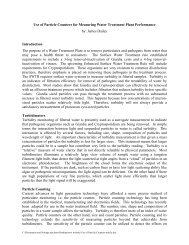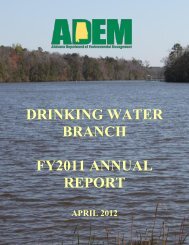- Page 1 and 2:
SURFACE WATER QUALITY SCREENING ASS
- Page 3 and 4:
Table of Contents TABLE OF CONTENTS
- Page 5 and 6:
List of Figures LIST OF FIGURES 1 C
- Page 7 and 8:
List of Abbreviations LIST OF ABBRE
- Page 9 and 10:
Introduction INTRODUCTION Backgroun
- Page 11 and 12:
Introduction document includes a de
- Page 13 and 14:
Introduction Table 1, cont. List of
- Page 15 and 16:
Methodology Table 7. Sub-watersheds
- Page 17 and 18:
Methodology Fig. 1. Cataloging unit
- Page 19 and 20:
Methodology Fig. 2. Level IV Ecoreg
- Page 21 and 22:
Methodology The southern section of
- Page 23 and 24:
Methodology The Southern Table Plat
- Page 25 and 26:
Methodology Table 8. Current conver
- Page 27 and 28:
Methodology SITE SELECTION Alabama
- Page 29 and 30:
Methodology Process samples in the
- Page 31 and 32:
Methodology Water quality samples a
- Page 33 and 34:
Summary: BWC River Basins Summary:
- Page 35 and 36:
Summary: BWC River Basins Fig. 3. C
- Page 37 and 38:
Summary: BWC River Basins Fig. 4. E
- Page 39 and 40: Summary: BWC River Basins Fig. 5. E
- Page 41 and 42: Summary: BWC River Basins Fig. 6. E
- Page 43 and 44: Summary: BWC River Basins Fig. 7. E
- Page 45 and 46: Summary: BWC River Basins Fig. 8. E
- Page 47 and 48: Summary: BWC River Basins Fig. 9. E
- Page 49 and 50: Summary: BWC River Basins Fig. 10.
- Page 51 and 52: Summary: BWC River Basins Fig. 11.
- Page 53 and 54: Summary: BWC River Basins Fig. 12.
- Page 55 and 56: Summary: BWC River Basins Fig. 13.
- Page 57 and 58: Summary: BWC River Basins Results o
- Page 59 and 60: Summary: BWC River Basins Impaired
- Page 61 and 62: THIS PAGE INTENTIONALLY BLANK 53
- Page 63 and 64: Summary: BWC River Basins Table 5,
- Page 65 and 66: THIS PAGE INTENTIONALLY BLANK 57
- Page 67 and 68: Cahaba River (0315-0202) Cahaba Riv
- Page 69 and 70: Cahaba River (0315-0202) Types of a
- Page 71 and 72: Cahaba River (0315-0202) Fig. 15. I
- Page 73 and 74: Cahaba River (0315-0202) Sub-Waters
- Page 75 and 76: Cahaba River (0315-0202) suspended
- Page 77 and 78: Cahaba River (0315-0202) indicating
- Page 79 and 80: Cahaba River (0315-0202) assessed a
- Page 81 and 82: Cahaba River (0315-0202) Assessment
- Page 83 and 84: Mulberry Fork (0316-0109) Program (
- Page 85 and 86: Mulberry Fork (0316-0109) Fig. 16.
- Page 87 and 88: Mulberry Fork (0316-0109) List of i
- Page 89: Mulberry Fork (0316-0109) Assessmen
- Page 93 and 94: Mulberry Fork (0316-0109) Assessmen
- Page 95 and 96: Mulberry Fork (0316-0109) Assessmen
- Page 97 and 98: Mulberry Fork (0316-0109) Eightmile
- Page 99 and 100: Mulberry Fork (0316-0109) Broglen R
- Page 101 and 102: Mulberry Fork (0316-0109) Assessmen
- Page 103 and 104: Mulberry Fork (0316-0109) Assessmen
- Page 105 and 106: Mulberry Fork (0316-0109) Sub-Water
- Page 107 and 108: Mulberry Fork (0316-0109) Sub-Water
- Page 109 and 110: Mulberry Fork (0316-0109) Sub-Water
- Page 111 and 112: Mulberry Fork (0316-0109) Bunkum Cr
- Page 113 and 114: Mulberry Fork (0316-0109) Assessmen
- Page 115 and 116: Mulberry Fork (0316-0109) Sub-Water
- Page 117 and 118: Mulberry Fork (0316-0109) Sub-Water
- Page 119 and 120: Mulberry Fork (0316-0110) Sipsey Fo
- Page 121 and 122: Mulberry Fork (0316-0110) waters. A
- Page 123 and 124: Sipsey Fork (0316-0110) Fig. 17. 20
- Page 125 and 126: Sipsey Fork (0316-0110) Sub-Watersh
- Page 127 and 128: Sipsey Fork (0316-0110) and GSA (Ap
- Page 129 and 130: Sipsey Fork (0316-0110) Assessment
- Page 131 and 132: Sipsey Fork (0316-0110) Sub-Watersh
- Page 133 and 134: Sipsey Fork (0316-0110) Sub-Watersh
- Page 135 and 136: Sipsey Fork (0316-0110) Sub-Watersh
- Page 137 and 138: Sipsey Fork (0316-0110) Sub-Watersh
- Page 139 and 140: Sipsey Fork (0316-0110) unstable ba
- Page 141 and 142:
Sipsey Fork (0316-0110) conditions
- Page 143 and 144:
Locust Fork (0316-0111) Historical
- Page 145 and 146:
Locust Fork (0316-0111) Fig. 18. 20
- Page 147 and 148:
Locust Fork (0316-0111) Upper Locus
- Page 149 and 150:
Locust Fork (0316-0111) ADEM 1999a)
- Page 151 and 152:
Locust Fork (0316-0111) and fair/po
- Page 153 and 154:
Locust Fork (0316-0111) bottom subs
- Page 155 and 156:
Locust Fork (0316-0111) Assessment
- Page 157 and 158:
Locust Fork (0316-0111) oxygen. ADE
- Page 159 and 160:
Locust Fork (0316-0111) Longs Branc
- Page 161 and 162:
Upper Black Warrior River (0316-011
- Page 163 and 164:
Upper Black Warrior River (0316-011
- Page 165 and 166:
Upper Black Warrior River (0316-011
- Page 167 and 168:
Upper Black Warrior River (0316-011
- Page 169 and 170:
Upper Black Warrior River (0316-011
- Page 171 and 172:
Upper Black Warrior River (0316-011
- Page 173 and 174:
Upper Black Warrior River (0316-011
- Page 175 and 176:
Upper Black Warrior River (0316-011
- Page 177 and 178:
Upper Black Warrior River (0316-011
- Page 179 and 180:
Lower Black Warrior River (0316-011
- Page 181 and 182:
THIS PAGE INTENTIONALLY BLANK 173
- Page 183 and 184:
Lower Black Warrior River (0316-011
- Page 185 and 186:
Lower Black Warrior River (0316-011
- Page 187 and 188:
Lower Black Warrior River (0316-011
- Page 189 and 190:
Lower Black Warrior River (0316-011
- Page 191 and 192:
Lower Black Warrior River (0316-011
- Page 193 and 194:
Lower Black Warrior River (0316-011
- Page 195 and 196:
Lower Black Warrior River (0316-011
- Page 197 and 198:
THIS PAGE INTENTIONALLY BLANK 189
- Page 199 and 200:
References ACES. 1997. Soil areas o
- Page 201 and 202:
References ADEM. 2002b. Nonpoint so
- Page 203 and 204:
References APHA, AWWA, and WEF. 199
- Page 205 and 206:
References Omernik, J.M. 1996. Leve
- Page 207 and 208:
APPENDICES
- Page 209 and 210:
Appendix A, cont. Land use percenta
- Page 211 and 212:
Appendix B--Page 1 of 3 Appendix B.
- Page 213 and 214:
Appendix B--Page 3 of 3 Appendix B,
- Page 215 and 216:
Appendix C-2. List of waterbodies w
- Page 217 and 218:
Appendix C-2, cont. List of waterbo
- Page 219 and 220:
Appendix D, cont. Estimates of (H)i
- Page 221 and 222:
Appendix D cont. Estimates of (H)ig
- Page 223 and 224:
Appendix E. Stations assessed in th
- Page 225 and 226:
Appendix E. Stations assessed in th
- Page 227 and 228:
Appendix E. Stations assessed in th
- Page 229 and 230:
Appendix E. Stations assessed in th
- Page 231 and 232:
Appendix E. Stations assessed in th
- Page 233 and 234:
Appendix E. Stations assessed in th
- Page 235 and 236:
Appendix E. Stations assessed in th
- Page 237 and 238:
Appendix E. Stations assessed in th
- Page 239 and 240:
Appendix E. Stations assessed in th
- Page 241 and 242:
Appendix E. Stations assessed in th
- Page 243 and 244:
Appendix E. Stations assessed in th
- Page 245 and 246:
Appendix E. Stations assessed in th
- Page 247 and 248:
Appendix E. Stations assessed in th
- Page 249 and 250:
Appendix E. Stations assessed in th
- Page 251 and 252:
Appendix E. Stations assessed in th
- Page 253 and 254:
Appendix E. Stations assessed in th
- Page 255 and 256:
Appendix E. Stations assessed in th
- Page 257 and 258:
Appendix E. Stations assessed in th
- Page 259 and 260:
Appendix E. Stations assessed in th
- Page 261 and 262:
Appendix E. Stations assessed in th
- Page 263 and 264:
Appendix F--Page 2 of 2 Appendix F,
- Page 265 and 266:
Appendix G, cont. Summary of assess
- Page 267 and 268:
Appendix G, cont. Summary of assess
- Page 269 and 270:
Appendix G, cont. Summary of assess
- Page 271 and 272:
Appendix H, cont. Estimates of anim
- Page 273 and 274:
Appendix H, cont. Estimates of anim
- Page 275 and 276:
Appendix H, cont. Estimates of anim
- Page 277 and 278:
Appendix H, cont. Estimates of anim
- Page 279 and 280:
Appendix I. Sedimentation estimates
- Page 281 and 282:
Appendix I, cont. Sedimentation est
- Page 283 and 284:
Appendix I, cont. Sedimentation est
- Page 285 and 286:
Appendix I, cont. Sedimentation est
- Page 287 and 288:
Appendix I, cont. Sedimentation est
- Page 289 and 290:
Appendix J, cont. Physical characte
- Page 291 and 292:
Appendix J, cont. Physical characte
- Page 293 and 294:
Appendix J, cont. Physical characte
- Page 295 and 296:
Appendix K. Bioassessment results f
- Page 297 and 298:
Appendix K. Bioassessment results f
- Page 299 and 300:
Appendix K. Bioassessment results f
- Page 301 and 302:
Appendix L-2. ADEM Glide/Pool habit
- Page 303 and 304:
ADEM — FIELD OPERATIONS DIVISION
- Page 305 and 306:
Appendix M--Page 2 of 3 Appendix M.
- Page 307 and 308:
Appendix N. Concentration of metals
- Page 309 and 310:
Appendix O-1. Physical characterist
- Page 311 and 312:
Appendix O-1. Physical characterist
- Page 313 and 314:
Appendix O-1. Physical characterist
- Page 315 and 316:
Appendix O-3. Physical/chemical dat
- Page 317 and 318:
Appendix O-3--Page 3 of 4 Appendix
- Page 319 and 320:
Appendix P. §303(d) Waterbody Moni
- Page 321 and 322:
Appendix P-1. Physical characterist
- Page 323 and 324:
Appendix P-1. Physical characterist
- Page 325 and 326:
Appendix P-1. Physical characterist
- Page 327 and 328:
Appendix P-2. Bioassessment results
- Page 329 and 330:
Appendix P-3. Physical/chemical dat
- Page 331 and 332:
Appendix P-3. Physical/chemical dat
- Page 333 and 334:
Appendix P-3. Physical/chemical dat
- Page 335 and 336:
Appendix P-3. Physical/chemical dat
- Page 337 and 338:
Appendix P-3. Physical/chemical dat
- Page 339 and 340:
Appendix P-3. Physical/chemical dat
- Page 341 and 342:
Appendix P-3. Physical/chemical dat
- Page 343 and 344:
Appendix P-3. Physical/chemical dat
- Page 345 and 346:
Appendix P-3. Physical/chemical dat
- Page 347 and 348:
Appendix P-3. Physical/chemical dat
- Page 349 and 350:
Appendix P-3. Physical/chemical dat
- Page 351 and 352:
Appendix P-3. Physical/chemical dat
- Page 353 and 354:
Appendix P-3. Physical/chemical dat
- Page 355 and 356:
Appendix Q. Periphyton Bioassessmen
- Page 357 and 358:
Appendix Q--Page 2 of 2 Appendix Q.
- Page 359 and 360:
Appendix R--Page 1 of 5 Appendix R.
- Page 361 and 362:
Appendix R--Page 3 of 5 Appendix R.
- Page 363 and 364:
Appendix R--Page 5 of 5 Appendix R.
- Page 365 and 366:
Appendix S--Page 1 of 9 Appendix S.
- Page 367 and 368:
Appendix S--Page 3 of 9 Appendix S.
- Page 369 and 370:
Appendix S--Page 5 of 9 Appendix S.
- Page 371 and 372:
Appendix S--Page 7 of 9 Appendix S.
- Page 373 and 374:
Appendix S. Physical/chemical data
- Page 375 and 376:
Appendix T-1. Results of habitat as
- Page 377 and 378:
Appendix T-1. Results of habitat as
- Page 379:
Appendix T-2--Page 1 of 1 Appendix


